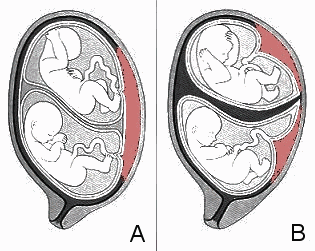|
|
|||||||||||||
|
|
4.1.7 MULTIPLE PREGNANCIES
TWO EXAMPLES OF TWINNING A. Identical Twins Fetuses are of the same sex and share one placenta. One outer membrane envelops both amniotic sacs. B. Fraternal Twins Fetuses may be of different sex. There are two placentas and two separate amniotic sacs, each with its own membrane. In some cases, the zygote may proceed to an external division and split up into two separate cells. These two new cells then continue their development independently as they undergo their own segmentation. Eventually, they both arrive in the uterus where they also implant separately. The result is a twin pregnancy. Since both came from the same egg and the same sperm, the twins will be identical, i.e., they will be of the same sex and, of course, also look alike in every other respect. Actually, identical twinning does not necessarily have to begin in the Fallopian tube, but can occur at any time between the second and fourteenth day after fertilization. Thus, even during implantation the blastocyst may still divide and grow into two separate embryos. There are also some very rare cases of multiple ovulation, i.e., the release of several eggs at the same time. If these eggs are then fertilized, they may, of course, produce multiple pregnancies. Twins born as a result of such a pregnancy are known as fraternal twins. If three of these children are born, they are called triplets, four are quadruplets, five are quintuplets, and so on. Since each of them comes from a different egg fertilized by a different sperm cell, they may be of different sex and will not resemble each other any more than other brothers and sisters. |

